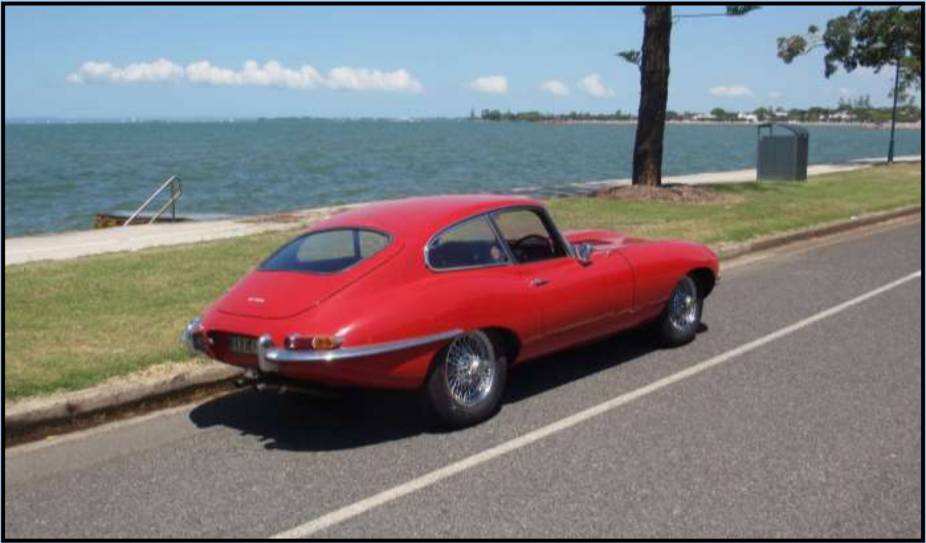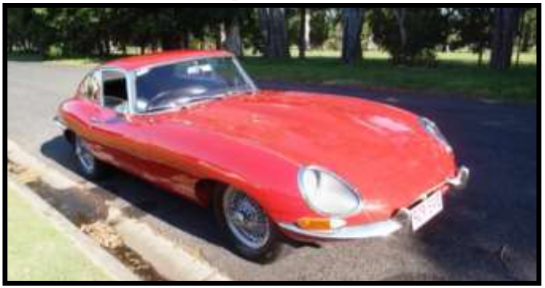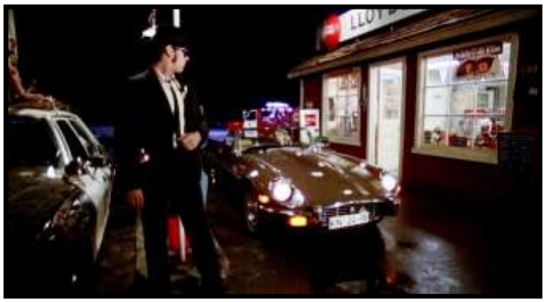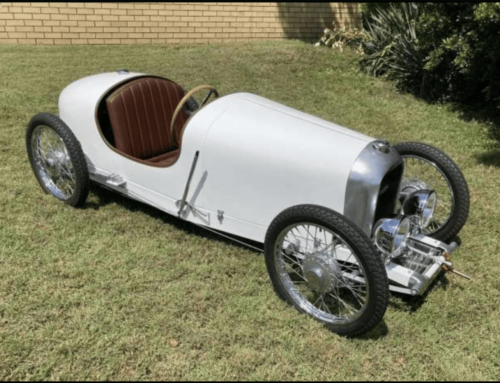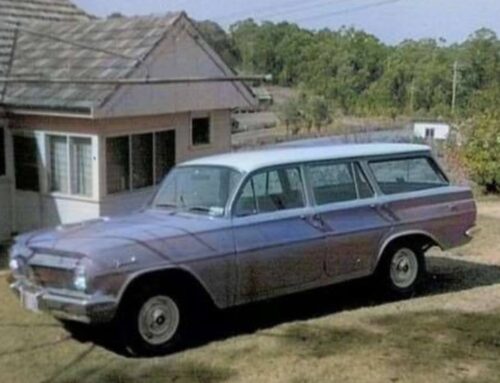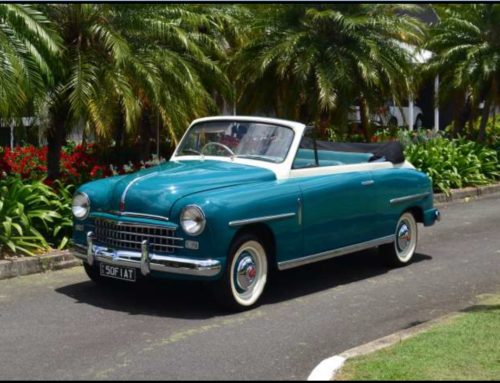1962 Jaguar E-Type Coupe – February – April 2023 Cover Story
The word “iconic” has been so carelessly misapplied and overused that its origins have long been forgotten. Nonetheless if anyone ever asked me “What does ‘iconic’ mean?” I’d unhesitatingly reply “Like the E-Type Jaguar”.
I first read of the E-Type in Popular Mechanics magazine in June 1961:
Jaguar’s new 150-mile-an-hour XK-E boasts a 3.8-litre engine with twin overhead cams, aluminium cylinder head and three carburettors. Designed for wider public appeal than former models, the car has interchangeable hard and soft tops, adjustable steering wheel and roll-up windows. The stressed-steel body allows the XK-E to be 600 pounds lighter than former models.
I wasn’t even in my teens then, and far more interested in steam locomotives and World War Two aircraft than cars, but the idea of a 150-mile-an-hour sports car was more exciting than anything I’d ever imagined.
Others who knew much more about cars and life in general were also impressed. Enzo Ferrari is reputed to have said that the E-Type was the most beautiful car in the world. David Boddy, MotorSport magazine’s highly-regarded writer, wrote in 1961 after his two-hour, 155 mile test drive that “The E-type is a staggering motor car on all counts: safety, acceleration, speed, equipment, appearance – all are there, for a basic price of only £1,480*. Staggering!”.
* Including sales tax the E-Type cost £2,097 for the roadster and £2,196 for the coupe and, in the US, $5,595 and $5,895 respectively.
Other writers were equally effusive, and with its powerful twin overhead cam engine, all-independent suspension, four-wheel disc brakes, semi-monocoque construction, breathtaking performance and staggering good looks the E-Type deserved such adulation.
But praise of the E-Type’s style and mechanical sophistication was contextual. Most UK and US car buyers drove sedans or station wagons, didn’t want a hot and cramped two-seater with a cranky gearbox and no room for groceries, and wouldn’t have heard of Enzo Ferrari or David Boddy nor cared what they thought.
Sports cars of the era were crude and unrefined compared to the E-Type. In the UK the most popular in the late 1950s and early 1960s – the MG-A, Triumph TR3A, Austin-Healey Sprite and Sunbeam Alpine – had pushrod engines, live rear axles and disc brakes only at the front. Only the E-Type’s predecessor XK150 could really compare. The E-Type was much more expensive – as much as three Sprites or two MG-As (though a few pounds cheaper than the XK150).
But at the other end of the market an Aston Martin DB4 saloon cost £3,968.
The US had the Chevrolet Corvette, but didn’t really need to build sports cars, as they imported them from the UK by the shipload. More than 80 percent of MG-As, Jaguar XKs, Triumph TR3s, 3As and 3Bs and Austin-Healey 100s went to the US market, and eventually nearly 80 percent of E-Types as well.
Unlike its UK counterpart the US music industry had realised that songs about fast cars would sell records to teenagers, and the early 1960s saw songs about the Ford Thunderbird, Corvette Stingray, Pontiac GTO and Ford Mustang. There weren’t many about MGs, Triumphs or Austin-Healeys, but the E-Type had its turn in 1963 with Jan and Dean’s “Dead Man’s Curve”:
I was cruisin’ in my Stingray late one night
When an XK-E pulled up on the right
And rolled down the window of his shiny new Jag
And challenged me then and there to a drag.
Then in 1964 Freddy Cannon’s much more upbeat “Abigail Beecher”:
Hey everybody, get out of the street now
I hear the roar of an XK-E now.
The E-Type also appeared in films and TV series such as Viva Las Vegas, A Shot in the Dark, Thunderball, Carry on Doctor, Casino Royale, The Italian Job, The Blues Brothers, Terms of Endearment, The Man from UNCLE, The Avengers and others. These song, film
and TV appearances showed that the E-Type had achieved the same almost-universal level of public awareness as million-selling cars like the VW Beetle, the Mini and the Ford Mustang.
As the E-Type sold only 72,515 units, few had the opportunity to realise that, like all other cars, it had its faults. Most cars of the era were prone to rust, but the E-Type’s huge sills are especially vulnerable. The cockpit is cramped, seats are uncomfortable with limited travel, there’s insufficient room around the pedals (especially for the driver), storage space is inadequate and heating and ventilation poor. Heat from the gearbox is overpowering, and anyone taller than 175cm will struggle to get in and out.
The December 1961 Car and Driver noted that “oil consumption seemed extraordinarily high … the transmission has poor synchromesh … the gearbox is definitely not on a par with the performance of the car as a whole and about the kindest thing we can say for it is that we didn’t like it”.
In 1967 the crucial US market demanded changes to meet impending safety and emissions legislation. Removal of the perspex headlamp covers, bulkier bumpers and bigger indicators, stop lights and front air intake all marred that 1961 perfection. Cars destined for the US now had twin Stromberg carburettors instead of the three beautiful SUs, so power was reduced and performance suffered.
The inevitable next step was to fit a bigger engine, and in 1971 Jaguar introduced the Series Three with the 5.3 litre V12 engine, but that’s another story. The E-Type was caught up in the inevitable collapse of the British-owned motor industry. Jaguar was merged several times, nationalized, de-merged and privatised, acquired by Ford and eventually sold to Tata Motors. Jaguars are still built in the UK, and, as with their E-predecessor, their safety, acceleration, speed, equipment and appearance are still staggering.
Geoff Moran (Popular Mechanics, aronline.co.uk, classicandsportscar.com)
Source : “The Bayside Vehicle Restorers Club Inc. Magazine”

